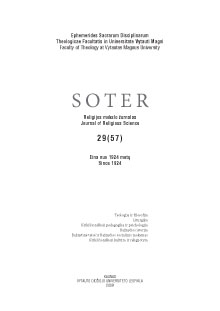Švč. Mergelės Marijos kultas lietuvių šeimos papročiuose
THE CULT OF THE BLESSED VIRGIN MARY IN LITHUANIAN FAMILY CUSTOMS
Author(s): Rasa Račiūnaitė-PaužuolienėSubject(s): Christian Theology and Religion
Published by: Vytauto Didžiojo Universitetas
Keywords: Švč. Mergelė Marija; kultas; liaudies pamaldumas; lietuvių šeimos papročiai; Blessed Virgin Mary; cult; folk devotion; Lithuanian family customs
Summary/Abstract: The article analyses the cult of the Blessed Virgin Mary and the forms of popular devotions in Lithuanian family customs. The work is based on the previous sources and the investigation materials gathered by the author in 1989-2007 in Lithuania, West Byelorussia (Gervėčiai district) and Poland (Punskas region). Some factors testify the forms of veneration of Mary: 1) the popular devotions to Our Lady in Lithuanian family customs; 2) the blessings of the Blessed Virgin Mary in Šiluva, where people obtain divine graces today; 3) the cult of Our Lady is spread by simple people. The forms of venerating Mary were propagated by different monks in the 17-18th c. c Later it was established in the Lithuanian family customs. The liturgical forms of venerating Mary were transformed into the new forms of popular devotions in Lithuanian family customs. The veneration of Our Lady testifies some forms of popular devotion in childbirth customs: the vow of a mother, prayers before a childbearing and after a childbearing, prayers after the Baptism, offering of a child to Mary, hymns, pilgrimages, the old rites of churching of women after childbirth. The veneration of Our Lady testifies some forms of popular devotion in wedding customs: blessing and reception rites of the newlyweds in their parents’ homesteads, a prayer of the newlyweds before Mary’s altar after the sacrament of matrimony; the shower rites of daughter-in-law in a bridegroom’s homestead. The popular devotion to Our Lady was observed in such funeral rites: mortifying, laying out, and chanting rites. There is a national veneration of the Blessed Mary until now. Significant role belongs to Mary’s shrines, such as Šiluva. The popular devotion to Mary in Šiluva became a manifestation of the resistance movement of Lithuanian Catholics during the Soviet occupation. Šiluva is the national unity place of Lithuanians today. Some facts testify popular devotion to the Blessed Virgin Mary of Šiluva: 1) pilgrimages on a feast day of the Birth of the Blessed Virgin Mary; 2) participation at the Holy Mass in Šiluva; 3) prayers in the apparition place of the Blessed Virgin Mary and at the miraculous painting of Mary; 4) going on knees round the altar of Mary’s apparition in the chapel, as well as, around the central Mary’s altar in the church of Šiluva; 5) gathering of pilgrims every month on the 13th day in Šiluva; 6) praying rosary and singing hymns to Mary.
Journal: SOTER: religijos mokslo žurnalas
- Issue Year: 57/2009
- Issue No: 29
- Page Range: 141-158
- Page Count: 16
- Language: Lithuanian

